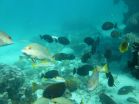Cost-effective conservation helps species bounce back
Researchers have developed a way to help ecosystems bounce back after human disturbances such as shipping, oil exploration or fishing, and have applied it to a coral reef fish species
2015-07-08
(Press-News.org) Researchers have developed a way to help ecosystems bounce back after human disturbances such as shipping, oil exploration or fishing, and have applied it to a coral reef fish species.
The method helps conservation managers create a cost-effective plan to bring species back from the brink of extinction in a local area, by building connections with the same species in nearby locations.
"The world is subject to nasty surprises, and this work for the first time shows how to promote faster species recovery following such a surprise," said Professor Quentin Grafton from the Crawford School of Public Policy at The Australian National University (ANU).
The cost of environmental damage can be substantial, and this new method developed jointly by ANU and CSIRO has the potential to quantify the cost and help direct resources for the best environmental outcomes.
"We show how to calculate the cost of offsetting environmental damage, which will help environmental managers make cost-effective decisions within their financial constraints," said Dr Richard Little from CSIRO Oceans and Atmosphere.
The method uses an ecological trait called resilience, which is based on connections between separate populations of the same species.
By optimising the connections between the different populations, the technique will enable conservation staff to work out the best course of recovery if an incident all but wipes out the species in one area.
"You can offset permanent loss of one ecological function by investment in another," said Professor Grafton.
The approach was specifically applied to a simulated disaster among spangled emperors, a coral reef fish, at Ningaloo Reef in Western Australia.
The method's power comes from simple principles that can be applied to complex ecosystems, Dr Little said.
"In a complicated world, the key result was simply sketched out on a white board."
INFORMATION:
[Attachments] See images for this press release:


ELSE PRESS RELEASES FROM THIS DATE:
2015-07-08
In the life of almost every household appliance, there comes that moment of out with the old and in with the new.
However, while electrical and electronic equipment have never been more efficient, economical or in demand, consumers' desire to own the best and the latest is contributing to an environmental issue of increasing seriousness and concern.
"E-waste is one of the fastest growing waste streams in developing, emerging and developed regions and it covers all electrical and electronic equipment and parts discarded by consumers," says Dr Sunil Herat, Associate Editor ...
2015-07-08
Nanowires are wired-shaped materials with diameters that are tens of nanometers or less. There are many types of nanowires, including semiconducting composite nanowires, metal oxide composite nanowires, and organic polymer nanowires, and they are typically used in functional materials and devices used as sensors, transistors, semiconductors, photonics devices, and solar cells.
Molecular wires composed of only inorganic materials have attracted significant attention due to their stable structures, tunable chemical compositions, and tunable properties. However, there have ...
2015-07-08
The research team led by Dr. Jongsoo Jurng and Dr. Gwi-Nam at KIST stated that, "In cooperation with KT&G, KIST has developed a nano-catalyst filter coated with a manganese oxide-based nano-catalyst, which can be used in a smoking room to reduce and purify major harmful substances of cigarette smoke. the KIST-developed catalyst removes 100% of the particle substances of cigarette smoke, such as nicotine and tar, converting those into water vapor and carbon dioxide. According to the research team, the air cleaning equipment based on the newly-developed catalyst can purify ...
2015-07-08
Heavy rainfall events setting ever new records have been increasing strikingly in the past thirty years. While before 1980, multi-decadal fluctuations in extreme rainfall events are explained by natural variability, a team of scientists of the Potsdam Institute for Climate Impact Research detected a clear upward trend in the past few decades towards more unprecedented daily rainfall events.
They find the worldwide increase to be consistent with rising global temperatures which are caused by greenhouse-gas emissions from burning fossil fuels. Short-term torrential rains ...
2015-07-08
Male badgers that spend their youth fighting tend to age more quickly than their passive counterparts according to new research from the University of Exeter.
The 35-year study revealed that male badgers living alongside a high density of other males grow old more quickly than those living with lower densities of males.
The results, which are published in the Proceedings of the Royal Society B, indicate that competition between males in early life accelerates ageing in later life, providing a potential explanation for why males age faster than females.
Author Christopher ...
2015-07-08
A review in The Obstetrician & Gynaecologist (TOG) finds that reducing the risk of stillbirth calls for better monitoring of women during their pregnancy to help find those whose babies' lives could be saved by early delivery.
In the UK the absolute risk of stillbirth is low, affecting approximately 4 in 1000 babies (MBRRACE). Although for most cases the exact cause of death is unclear, stillbirth is associated with complications during childbirth, maternal infections during pregnancy, maternal health conditions such as high blood pressure or diabetes, foetal growth restriction ...
2015-07-07
Several recent U.S. health policies, including the Affordable Care Act, provide incentives for transforming the delivery of health care to improve its value for dollar. Michael K. Gusmano, a Hastings Center scholar, and Frank J. Thompson, a distinguished professor at Rutgers University, critically examine efforts to shape the delivery of Medicaid through demonstration projects called Delivery System Reform Incentive Payment Initiatives (DSRIP). Despite political enthusiasm for DSRIP, they conclude in an article in Health Affairs that the evidence supporting its effectiveness ...
2015-07-07
Experiments by Carnegie Mellon University showed that significantly fewer women than men were shown online ads promising them help getting jobs paying more than $200,000, raising questions about the fairness of targeting ads online.
The study of Google ads, using a CMU-developed tool called AdFisher that runs experiments with simulated user profiles, established that the gender discrimination was real, said Anupam Datta, associate professor of computer science and of electrical and computer engineering. Still unknown, he emphasized, is who or what is responsible. Was ...
2015-07-07
Office work will become much less of a pain in the neck if Julie Côté has her way. That`s because this kinesiology researcher who teaches at McGill University is interested in finding ways to reduce or even prevent the kinds of muscular and skeletal stresses and pains that will affect one in ten office workers at some point in their careers. "Even though office workers may not naturally see it that way, their body is basically their work instrument, just as it is for an athlete," says Côté. "It can get injured in similar ways and for similar reasons: ...
2015-07-07
PORTLAND, Ore. - Scientists at Oregon Health & Science University, Stanford University, University of Valencia and IGENOMIX have discovered that chromosomal abnormalities in human embryos created for in vitro fertilization, or IVF, can be predicted within the first 30 hours of development at the cell-1 stage which results from the union of a female egg and male sperm.
This discovery, published online today in the journal Nature Communications, could improve IVF success rates, which has hovered around 30 to 35 percent for numerous years worldwide. It is estimated that ...
LAST 30 PRESS RELEASES:
[Press-News.org] Cost-effective conservation helps species bounce back
Researchers have developed a way to help ecosystems bounce back after human disturbances such as shipping, oil exploration or fishing, and have applied it to a coral reef fish species





